神经网络学习文章
医学影像分析中的卷积神经网络使用教程
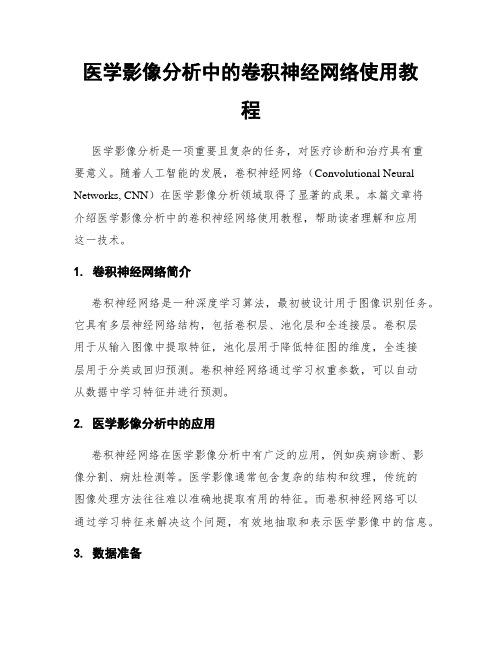
医学影像分析中的卷积神经网络使用教程医学影像分析是一项重要且复杂的任务,对医疗诊断和治疗具有重要意义。
随着人工智能的发展,卷积神经网络(Convolutional Neural Networks, CNN)在医学影像分析领域取得了显著的成果。
本篇文章将介绍医学影像分析中的卷积神经网络使用教程,帮助读者理解和应用这一技术。
1. 卷积神经网络简介卷积神经网络是一种深度学习算法,最初被设计用于图像识别任务。
它具有多层神经网络结构,包括卷积层、池化层和全连接层。
卷积层用于从输入图像中提取特征,池化层用于降低特征图的维度,全连接层用于分类或回归预测。
卷积神经网络通过学习权重参数,可以自动从数据中学习特征并进行预测。
2. 医学影像分析中的应用卷积神经网络在医学影像分析中有广泛的应用,例如疾病诊断、影像分割、病灶检测等。
医学影像通常包含复杂的结构和纹理,传统的图像处理方法往往难以准确地提取有用的特征。
而卷积神经网络可以通过学习特征来解决这个问题,有效地抽取和表示医学影像中的信息。
3. 数据准备在使用卷积神经网络进行医学影像分析之前,我们需要准备好训练数据和测试数据。
训练数据是用于训练网络的样本,通常需要标记或注释,以提供预期的输出结果。
测试数据用于评估网络的性能,通常没有标记,需要进行预测并与真实结果进行比较。
4. 构建卷积神经网络模型构建卷积神经网络模型是医学影像分析中的关键步骤。
我们可以选择不同的网络结构和层数,根据具体的任务需求进行调整。
一般来说,常用的卷积神经网络结构有LeNet、AlexNet、VGG、GoogLeNet和ResNet等。
5. 数据预处理在输入数据进入卷积神经网络之前,需要进行预处理以提高网络性能和准确度。
常见的数据预处理方法包括图像增强、去噪、标准化和数据增强等。
图像增强用于增加图像的对比度和清晰度,去噪可以减少噪声对网络的影响,标准化可以将像素值映射到相同的尺度范围,数据增强可以增加样本的多样性和丰富性。
理解卷积神经网络中的自注意力机制
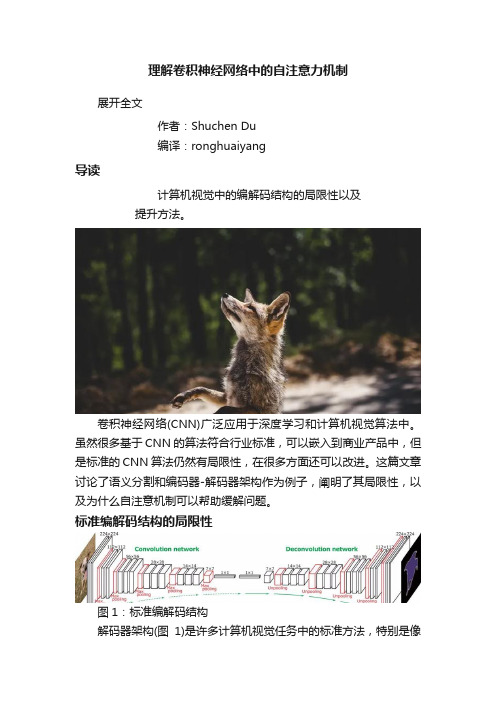
理解卷积神经网络中的自注意力机制展开全文作者:Shuchen Du编译:ronghuaiyang导读计算机视觉中的编解码结构的局限性以及提升方法。
卷积神经网络(CNN)广泛应用于深度学习和计算机视觉算法中。
虽然很多基于CNN的算法符合行业标准,可以嵌入到商业产品中,但是标准的CNN算法仍然有局限性,在很多方面还可以改进。
这篇文章讨论了语义分割和编码器-解码器架构作为例子,阐明了其局限性,以及为什么自注意机制可以帮助缓解问题。
标准编解码结构的局限性图1:标准编解码结构解码器架构(图1)是许多计算机视觉任务中的标准方法,特别是像素级预测任务,如语义分割、深度预测和一些与GAN相关的图像生成器。
在编码器-解码器网络中,输入图像进行卷积、激活以及池化得到一个潜向量,然后恢复到与输入图像大小相同的输出图像。
该架构是对称的,由精心设计的卷积块组成。
由于其简单和准确,该体系结构被广泛使用。
图2:卷积的计算但是,如果我们深入研究卷积的计算(图2),编码器-解码器架构的局限性就会浮出表面。
例如,在3x3卷积中,卷积滤波器有9个像素,目标像素的值仅参照自身和周围的8个像素计算。
这意味着卷积只能利用局部信息来计算目标像素,这可能会带来一些偏差,因为看不到全局信息。
也有一些朴素的方法来缓解这个问题:使用更大的卷积滤波器或有更多卷积层的更深的网络。
然而,计算开销越来越大,结果并没有得到显著的改善。
理解方差和协方差方差和协方差都是统计学和机器学习中的重要概念。
它们是为随机变量定义的。
顾名思义,方差描述的是单个随机变量与其均值之间的偏差,而协方差描述的是两个随机变量之间的相似性。
如果两个随机变量的分布相似,它们的协方差很大。
否则,它们的协方差很小。
如果我们将feature map中的每个像素作为一个随机变量,计算所有像素之间的配对协方差,我们可以根据每个预测像素在图像中与其他像素之间的相似性来增强或减弱每个预测像素的值。
在训练和预测时使用相似的像素,忽略不相似的像素。
量子力学模拟神经网络功能

量子力学模拟神经网络功能量子力学和神经网络是两个当今科学领域中备受关注的领域。
量子力学探索微观世界的行为,而神经网络模拟人脑神经元的工作方式。
近年来,科学家们开始尝试结合这两个领域,以期望发现新的科学突破和应用前景。
本篇文章将围绕量子力学模拟神经网络功能展开讨论。
首先,让我们先了解什么是量子力学。
量子力学是基于量子理论的一个学科,研究微观粒子的行为规律和性质。
它提供了一种非常精确的描述微观粒子运动和相互作用的数学框架,可以用来解释和预测电子、光子等微观粒子的行为。
神经网络是一种模拟人脑神经元工作方式的系统。
它由许多人工神经元(节点)组成,通过连接权重和激活函数来模拟神经元之间的信息传递和处理。
神经网络通过学习和训练,可以解决各种问题,如图像识别、语音识别和自然语言处理等。
量子力学模拟神经网络是一种新兴的研究领域,旨在利用量子力学的性质来增强神经网络的功能。
量子力学的一些特性,如叠加态和纠缠态,可以提供在传统计算中不可实现的处理能力和信息传递速度。
一种应用量子力学模拟神经网络的方法是量子神经网络(Quantum Neural Network,QNN)。
QNN利用量子比特(Qubit)作为信息处理的基本单位,通过调控量子叠加态和纠缠态,提供对数据进行更复杂和高效处理的能力。
QNN可以在机器学习和数据处理领域中发挥重要作用,例如优化问题求解、模式识别和数据压缩等。
另一种应用量子力学模拟神经网络的方法是量子机器学习(Quantum Machine Learning,QML)。
QML利用量子力学的特性来改进传统机器学习算法,提高算法的效率和性能。
例如,量子支持向量机(Quantum Support Vector Machines,QSVM)可以通过利用量子计算的优势来加快分类和回归问题的求解过程。
量子神经网络(Quantum Neural Networks,QNNs)也可以用来训练和优化神经网络的参数。
除了在机器学习领域,量子力学模拟神经网络还可以应用于模拟生物系统和神经科学研究中。
neural processing letters文章模板 -回复

neural processing letters文章模板-回复问题,并陈述相关论点和论据。
【标题】神经处理信件:探索人脑与人工神经网络的相似之处【引言】人类的大脑一直被视为自然界最复杂且神秘的系统之一。
然而,随着人工智能的快速发展,人们开始对人脑与人工神经网络之间的相似之处产生了浓厚的兴趣。
本文将探讨神经处理信件,旨在回答关于人脑与人工神经网络相似性的问题,并提供支持这一观点的论据。
【主体】1. 人脑与神经网络相似的工作原理1.1 生物神经元和人工神经元的相似性论据:生物神经元和人工神经元在功能和结构上有诸多相似之处。
论据:生物神经元和人工神经元都能够接收、处理和传递信息。
1.2 神经网络与人脑神经元的连接性论据:神经网络的连接性模仿了人脑神经元之间的连接方式。
论据:人脑与神经网络均通过突触连接来传递信息。
2. 人工智能与认知能力的相似性2.1 神经网络训练与人类学习的相似性论据:神经网络通过反复训练来提高性能,这与人类学习的过程相似。
论据:神经网络通过调整权重和连接方式来优化性能,类似于人脑通过突触强化来加强连接。
2.2 神经网络能力模型与人类认知过程的相似性论据:神经网络在解决特定任务时,像人类一样使用特征提取和模式识别。
论据:神经网络具有分层结构,这类似于人脑的认知处理层次。
3. 人脑与神经网络的局限性3.1 人脑的复杂性和神经网络的简化性论据:人脑的结构和功能远比神经网络复杂得多。
论据:神经网络是人脑的简化模型,忽略了许多真实神经系统中存在的复杂细节。
3.2 神经网络对数据的依赖和人脑的灵活性论据:神经网络需要大量数据进行训练,而人脑可以通过少量数据进行学习和推理。
论据:人脑能够根据环境变化灵活调整和适应,而神经网络的适应性相较之下较为有限。
【结论】尽管人脑与人工神经网络之间存在相似性,但人脑的复杂性和灵活性依然是我们需要继续研究和模仿的领域。
通过探索人脑与人工神经网络的相似之处,我们能够更好地理解人脑的运作机制,并进一步改进人工智能系统的性能和能力。
神经网络基本知识

神经网络基本知识一、内容简述神经网络是机器学习的一个重要分支,是一种模拟生物神经网络结构和功能的计算模型。
它以其强大的学习能力和自适应能力广泛应用于多个领域,如图像识别、语音识别、自然语言处理等。
《神经网络基本知识》这篇文章将带领读者了解神经网络的基本概念、原理和应用。
1. 神经网络概述神经网络是一种模拟生物神经系统结构和功能的计算模型。
它由大量神经元相互连接构成,通过学习和调整神经元之间的连接权重来进行数据处理和模式识别。
神经网络的概念自上世纪五十年代提出以来,经历了漫长的发展历程,逐渐从简单的线性模型演变为复杂的多层非线性结构。
神经网络在人工智能领域发挥着核心作用,广泛应用于计算机视觉、语音识别、自然语言处理等领域。
神经网络的基本构成单元是神经元,每个神经元接收来自其他神经元的输入信号,通过特定的计算方式产生输出信号,并传递给其他神经元。
不同神经元之间的连接强度称为权重,通过训练过程不断调整和优化。
神经网络的训练过程主要是通过反向传播算法来实现的,通过计算输出层误差并反向传播到输入层,不断调整权重以减小误差。
神经网络具有强大的自适应能力和学习能力,能够处理复杂的模式识别和预测任务。
与传统的计算机程序相比,神经网络通过学习大量数据中的规律和特征,自动提取高级特征表示,避免了手动设计和选择特征的繁琐过程。
随着深度学习和大数据技术的不断发展,神经网络的应用前景将更加广阔。
神经网络是一种模拟生物神经系统功能的计算模型,通过学习和调整神经元之间的连接权重来进行数据处理和模式识别。
它在人工智能领域的应用已经取得了巨大的成功,并将在未来继续发挥重要作用。
2. 神经网络的历史背景与发展神经网络的历史可以追溯到上个世纪。
最初的神经网络概念起源于仿生学,模拟生物神经网络的结构和功能。
早期的神经网络研究主要集中在模式识别和机器学习的应用上。
随着计算机科学的快速发展,神经网络逐渐成为一个独立的研究领域。
在20世纪80年代和90年代,随着反向传播算法和卷积神经网络的提出,神经网络的性能得到了显著提升。
神经网络基础知识

神经网络基础知识神经网络是一种模拟大脑处理信息的计算机系统。
神经网络通过自动学习和适应来执行任务,例如图像和语音识别。
对于普通人来说,理解神经网络可能有些困难。
因此,我们准备了这篇文章,以帮助您了解神经网络的基本知识。
1.神经元神经元是神经网络最基本的组成部分。
神经元接收输入信号,将其加权处理,然后传递给下一个神经元。
每个神经元都有一个阈值,当加权输入信号超过该阈值时,它产生一个输出信号。
神经元的目的是对输入信号进行分类或数据处理。
可以通过调整神经元之间的连接权重来改变神经元的行为,从而调整神经网络的性能。
2.神经网络神经网络由许多相互连接的神经元组成,这些神经元可以分为层。
每个神经元接收其上一层的输出信号,加权后将其传递到下一层。
一般而言,神经网络通常有三层:输入层,隐藏层和输出层。
输入层接收外部输入,并将其传递到隐藏层。
隐藏层在接收输入信号后产生新特征,这些新特征可以用于进一步处理,最终生成输出。
输出层将处理后的结果展示给用户。
3.训练神经网络训练神经网络分为两个步骤:前向传递和反向传递。
·前向传递:给网络提供输入数据,网络经过处理后,输出一个结果。
·反向传递:通过改变神经元之间的连接权重(weight)来训练神经网络,在误差反向传播的过程中逐渐调整。
误差越小,神经网络的性能就越好。
4.损失函数损失函数的主要功能是对神经网络的性能进行评估。
损失函数可以描述神经网络的误差和数据之间的差异。
损失函数的大小越小,神经网络的性能就越好。
常用的损失函数有平方损失函数、交叉熵损失函数、绝对值损失函数等。
5.深度学习深度学习是一种基于神经网络的机器学习方法,这种方法通过将多层神经网络组合起来来模拟人类大脑的学习方式。
深度学习的一个优点是可以在没有人工干预的情况下自动学习。
由于网络和数据集的复杂性,深度学习的计算成本很高,但是随着技术的发展,越来越多的公司和研究机构正在将深度学习应用于实际场景中。
神经网络模型及训练方法
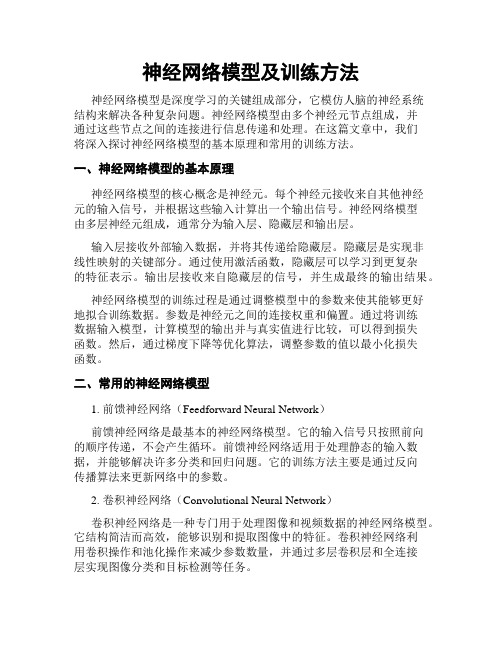
神经网络模型及训练方法神经网络模型是深度学习的关键组成部分,它模仿人脑的神经系统结构来解决各种复杂问题。
神经网络模型由多个神经元节点组成,并通过这些节点之间的连接进行信息传递和处理。
在这篇文章中,我们将深入探讨神经网络模型的基本原理和常用的训练方法。
一、神经网络模型的基本原理神经网络模型的核心概念是神经元。
每个神经元接收来自其他神经元的输入信号,并根据这些输入计算出一个输出信号。
神经网络模型由多层神经元组成,通常分为输入层、隐藏层和输出层。
输入层接收外部输入数据,并将其传递给隐藏层。
隐藏层是实现非线性映射的关键部分。
通过使用激活函数,隐藏层可以学习到更复杂的特征表示。
输出层接收来自隐藏层的信号,并生成最终的输出结果。
神经网络模型的训练过程是通过调整模型中的参数来使其能够更好地拟合训练数据。
参数是神经元之间的连接权重和偏置。
通过将训练数据输入模型,计算模型的输出并与真实值进行比较,可以得到损失函数。
然后,通过梯度下降等优化算法,调整参数的值以最小化损失函数。
二、常用的神经网络模型1. 前馈神经网络(Feedforward Neural Network)前馈神经网络是最基本的神经网络模型。
它的输入信号只按照前向的顺序传递,不会产生循环。
前馈神经网络适用于处理静态的输入数据,并能够解决许多分类和回归问题。
它的训练方法主要是通过反向传播算法来更新网络中的参数。
2. 卷积神经网络(Convolutional Neural Network)卷积神经网络是一种专门用于处理图像和视频数据的神经网络模型。
它结构简洁而高效,能够识别和提取图像中的特征。
卷积神经网络利用卷积操作和池化操作来减少参数数量,并通过多层卷积层和全连接层实现图像分类和目标检测等任务。
3. 循环神经网络(Recurrent Neural Network)循环神经网络是一种具有循环连接的神经网络模型。
它能够处理序列数据,并具有记忆能力。
循环神经网络通过在时间上展开,将过去的信息传递给未来,从而建立起对序列数据的依赖关系。
基于神经网络的机械产品结构优化设计研究
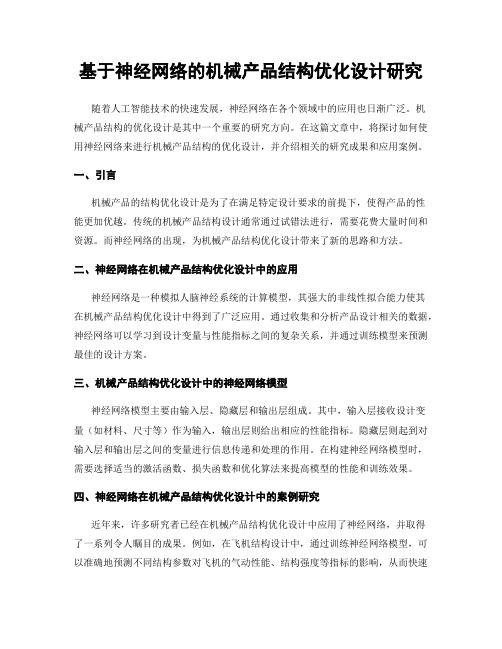
基于神经网络的机械产品结构优化设计研究随着人工智能技术的快速发展,神经网络在各个领域中的应用也日渐广泛。
机械产品结构的优化设计是其中一个重要的研究方向。
在这篇文章中,将探讨如何使用神经网络来进行机械产品结构的优化设计,并介绍相关的研究成果和应用案例。
一、引言机械产品的结构优化设计是为了在满足特定设计要求的前提下,使得产品的性能更加优越。
传统的机械产品结构设计通常通过试错法进行,需要花费大量时间和资源。
而神经网络的出现,为机械产品结构优化设计带来了新的思路和方法。
二、神经网络在机械产品结构优化设计中的应用神经网络是一种模拟人脑神经系统的计算模型,其强大的非线性拟合能力使其在机械产品结构优化设计中得到了广泛应用。
通过收集和分析产品设计相关的数据,神经网络可以学习到设计变量与性能指标之间的复杂关系,并通过训练模型来预测最佳的设计方案。
三、机械产品结构优化设计中的神经网络模型神经网络模型主要由输入层、隐藏层和输出层组成。
其中,输入层接收设计变量(如材料、尺寸等)作为输入,输出层则给出相应的性能指标。
隐藏层则起到对输入层和输出层之间的变量进行信息传递和处理的作用。
在构建神经网络模型时,需要选择适当的激活函数、损失函数和优化算法来提高模型的性能和训练效果。
四、神经网络在机械产品结构优化设计中的案例研究近年来,许多研究者已经在机械产品结构优化设计中应用了神经网络,并取得了一系列令人瞩目的成果。
例如,在飞机结构设计中,通过训练神经网络模型,可以准确地预测不同结构参数对飞机的气动性能、结构强度等指标的影响,从而快速得到优化的设计方案。
在汽车工业中,通过神经网络模型的优化设计,可以有效地降低汽车的重量,提高燃油效率和行驶稳定性。
五、机械产品结构优化设计中存在的挑战和解决方案虽然神经网络在机械产品结构优化设计中具有巨大的潜力,但仍然存在一些挑战。
例如,数据不足、训练时间过长等问题。
为了解决这些问题,研究者采用了一系列的解决方案,如引入模拟数据和增强学习技术。
resnet文章
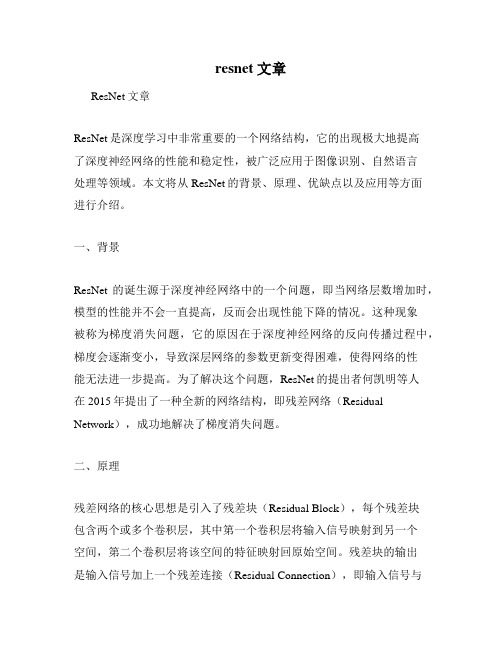
resnet文章ResNet文章ResNet是深度学习中非常重要的一个网络结构,它的出现极大地提高了深度神经网络的性能和稳定性,被广泛应用于图像识别、自然语言处理等领域。
本文将从ResNet的背景、原理、优缺点以及应用等方面进行介绍。
一、背景ResNet的诞生源于深度神经网络中的一个问题,即当网络层数增加时,模型的性能并不会一直提高,反而会出现性能下降的情况。
这种现象被称为梯度消失问题,它的原因在于深度神经网络的反向传播过程中,梯度会逐渐变小,导致深层网络的参数更新变得困难,使得网络的性能无法进一步提高。
为了解决这个问题,ResNet的提出者何凯明等人在2015年提出了一种全新的网络结构,即残差网络(Residual Network),成功地解决了梯度消失问题。
二、原理残差网络的核心思想是引入了残差块(Residual Block),每个残差块包含两个或多个卷积层,其中第一个卷积层将输入信号映射到另一个空间,第二个卷积层将该空间的特征映射回原始空间。
残差块的输出是输入信号加上一个残差连接(Residual Connection),即输入信号与输出信号之间的差异。
残差连接的作用在于保留输入信号的信息,使得网络可以更加容易地学习到残差的特征,从而提高网络的性能和稳定性。
三、优缺点ResNet的优点在于它可以训练非常深的神经网络,而不会出现梯度消失问题,使得深层网络的性能可以进一步提高。
此外,ResNet的残差块可以很好地保留输入信号的信息,从而提高网络的泛化能力和稳定性。
但是,ResNet的缺点在于它的计算量较大,需要更多的计算资源和时间,同时也需要更多的数据进行训练,否则容易出现过拟合的情况。
四、应用ResNet已经被广泛应用于图像识别、目标检测、语音识别、自然语言处理等领域。
在图像识别领域,ResNet在ImageNet比赛中获得了第一名,使得图像识别的性能得到了极大地提高。
在目标检测领域,ResNet可以很好地提取图像的特征,从而实现更加准确和快速的目标检测。
吴恩达2篇
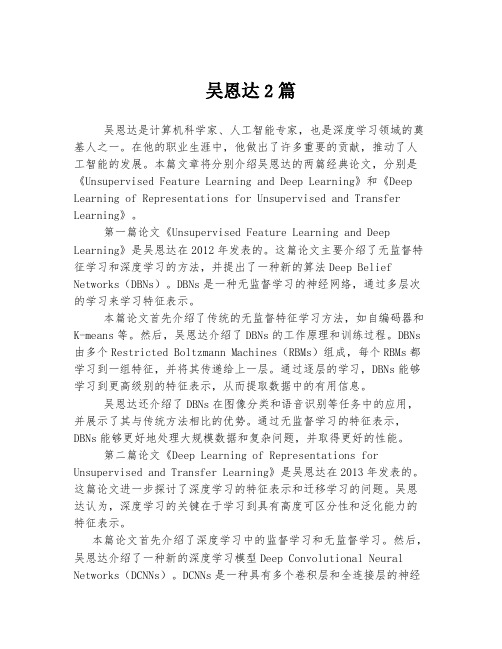
吴恩达2篇吴恩达是计算机科学家、人工智能专家,也是深度学习领域的奠基人之一。
在他的职业生涯中,他做出了许多重要的贡献,推动了人工智能的发展。
本篇文章将分别介绍吴恩达的两篇经典论文,分别是《Unsupervised Feature Learning and Deep Learning》和《Deep Learning of Representations for Unsupervised and Transfer Learning》。
第一篇论文《Unsupervised Feature Learning and Deep Learning》是吴恩达在2012年发表的。
这篇论文主要介绍了无监督特征学习和深度学习的方法,并提出了一种新的算法Deep Belief Networks(DBNs)。
DBNs是一种无监督学习的神经网络,通过多层次的学习来学习特征表示。
本篇论文首先介绍了传统的无监督特征学习方法,如自编码器和K-means等。
然后,吴恩达介绍了DBNs的工作原理和训练过程。
DBNs 由多个Restricted Boltzmann Machines(RBMs)组成,每个RBMs都学习到一组特征,并将其传递给上一层。
通过逐层的学习,DBNs能够学习到更高级别的特征表示,从而提取数据中的有用信息。
吴恩达还介绍了DBNs在图像分类和语音识别等任务中的应用,并展示了其与传统方法相比的优势。
通过无监督学习的特征表示,DBNs能够更好地处理大规模数据和复杂问题,并取得更好的性能。
第二篇论文《Deep Learning of Representations for Unsupervised and Transfer Learning》是吴恩达在2013年发表的。
这篇论文进一步探讨了深度学习的特征表示和迁移学习的问题。
吴恩达认为,深度学习的关键在于学习到具有高度可区分性和泛化能力的特征表示。
本篇论文首先介绍了深度学习中的监督学习和无监督学习。
神经网络基础知识介绍
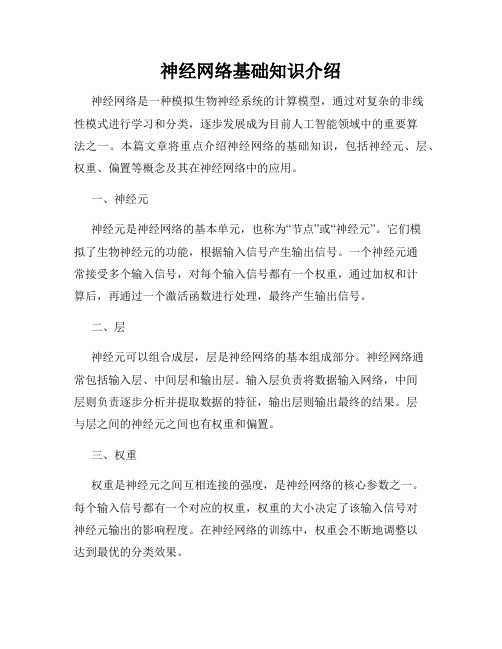
神经网络基础知识介绍神经网络是一种模拟生物神经系统的计算模型,通过对复杂的非线性模式进行学习和分类,逐步发展成为目前人工智能领域中的重要算法之一。
本篇文章将重点介绍神经网络的基础知识,包括神经元、层、权重、偏置等概念及其在神经网络中的应用。
一、神经元神经元是神经网络的基本单元,也称为“节点”或“神经元”。
它们模拟了生物神经元的功能,根据输入信号产生输出信号。
一个神经元通常接受多个输入信号,对每个输入信号都有一个权重,通过加权和计算后,再通过一个激活函数进行处理,最终产生输出信号。
二、层神经元可以组合成层,层是神经网络的基本组成部分。
神经网络通常包括输入层、中间层和输出层。
输入层负责将数据输入网络,中间层则负责逐步分析并提取数据的特征,输出层则输出最终的结果。
层与层之间的神经元之间也有权重和偏置。
三、权重权重是神经元之间互相连接的强度,是神经网络的核心参数之一。
每个输入信号都有一个对应的权重,权重的大小决定了该输入信号对神经元输出的影响程度。
在神经网络的训练中,权重会不断地调整以达到最优的分类效果。
四、偏置偏置是每个神经元的一个常数项,用于控制神经元的激活状态。
偏置通常被设置为一个较小的值,以确保神经元能够在没有输入信号的情况下仍然处于激活状态。
五、前向传播前向传播是神经网络中最基本的计算过程之一,也称为“向前计算”或“前向推理”。
在前向传播过程中,输入数据从输入层顺序传递到隐藏层和输出层,直至产生最终的输出结果。
神经网络的预测和分类都是基于前向传播算法完成的。
六、反向传播反向传播是神经网络中最重要的学习算法之一,用于不断调整神经网络的权重和偏置以提高其分类能力。
在反向传播过程中,先计算输出层的误差,再按照一定的规则将误差反向传播到每一层的神经元中,从而计算每个神经元上的误差,并根据这些误差值来更新神经元之间的权重和偏置。
综上所述,神经网络作为一种模拟生物神经系统的计算模型,通过不断学习和调整,在图像识别、自然语言处理、语音识别等领域中都发挥了越来越重要的作用。
神经元信号处理和神经网络动力学研究

神经元信号处理和神经网络动力学研究是神经科学领域的热点研究方向之一。
随着神经科学研究的深入,人们对神经元信号处理和神经网络动力学的理解也不断深入。
在这篇文章中,我们将从神经元的基础结构开始,介绍神经元信号处理和神经网络动力学的相关知识。
神经元是神经系统的基本单元,负责接收、处理和发送来自周围环境的信息。
神经元由细胞体、树突、轴突等结构组成。
当神经元受到刺激时,其细胞体内会产生电位变化,这种电位变化会通过轴突传递到神经元连接的其他神经元或肌肉纤维,实现信息传递。
神经元信号处理是指神经元接收、判别和处理信息的过程。
神经网络动力学是指神经元之间相互作用所形成的神经网络系统的动态变化。
神经网络动力学是神经科学的重要研究方向之一,可以用于理解大脑的信息处理方式和一些神经系统疾病的机理。
神经网络动力学涉及神经元之间的突触转移、神经元的兴奋和抑制、神经元信号传递等一系列过程。
神经元信号处理和神经网络动力学之间有着密不可分的联系。
神经元接收的信号会迅速传递到轴突,然后通过轴突尖端释放神经递质,在神经突触与其他神经元连接点进行信号传递。
神经网络动力学通过研究神经元之间的相互作用研究神经元的计算和信号传递过程。
神经网络动力学的研究可以反向推导神经元信号处理的过程,为神经元信号处理的机理提供理论基础。
目前,主要依靠计算模拟和实验研究两种方式。
计算模拟通常通过构建神经元模型和神经网络模型来模拟神经元信号处理和神经网络动力学的过程,利用计算机模拟和分析神经元之间的相互作用、神经元与环境的交互过程等。
实验研究则通过观察和测试神经元和神经网络的真实信号和行为来研究神经元信号处理和神经网络动力学的过程。
虽然已经取得了一些突破性进展,但是仍存在一些挑战。
一方面,神经元信号传递和神经网络动力学的机制非常复杂,需要结合多学科的知识才能深入了解。
另一方面,神经元信号传递和神经网络动力学的探究需要大量的计算模拟和实验研究,需要投入大量的时间和精力。
了解深度学习技术中的浅层神经网络

了解深度学习技术中的浅层神经网络浅层神经网络是深度学习中的一个重要概念。
它是一种由输入层、隐藏层和输出层组成的神经网络结构。
与深度神经网络相比,浅层神经网络的隐藏层较少,常常只有一层或者两层。
这篇文章将介绍浅层神经网络的背景、基本原理以及应用领域。
首先,让我们了解神经网络的基本概念。
神经网络是一种模拟人类大脑工作方式的计算系统。
它由大量的人工神经元组成,每个神经元通过连接权重与其他神经元相连。
神经网络可以通过训练来调整连接权重,以实现模式识别、分类、回归等任务。
深度学习是神经网络中的一种方法,其核心思想是通过增加神经网络的深度来提取更加复杂、抽象的特征。
然而,并非所有的任务都需要非常复杂的深层神经网络。
在某些情况下,浅层神经网络已经可以取得很好的效果。
浅层神经网络相比深层神经网络具有以下优势:首先,浅层神经网络的训练时间较短。
深层神经网络通常需要更多的计算资源和时间来训练,而浅层神经网络则可以在较短的时间内得到结果。
其次,浅层神经网络的模型较为简单。
深层神经网络由于层数较多,参数较多,往往更容易过拟合。
而浅层神经网络在参数较少的情况下,更容易泛化,避免过拟合现象的出现。
另外,浅层神经网络的解释性较强。
深度神经网络由于层数较多,模型较为复杂,其具体的决策过程往往难以解释。
而浅层神经网络由于结构相对简单,决策过程更容易理解和解释。
浅层神经网络在实际应用中有着广泛的应用。
下面是几个典型的应用领域:第一,图像分类与识别。
浅层神经网络常常被用于图像分类与识别任务中。
通过提取图像的低级特征和高级特征,并经过适当的训练,可以实现对图像的准确分类和识别。
第二,语音识别。
浅层神经网络也广泛应用于语音识别领域。
通过对语音信号的特征提取和模式识别,可以实现对不同语音的准确识别与转录。
第三,自然语言处理。
浅层神经网络可以被应用于文本分类、情感分析、问答系统等自然语言处理任务中。
其通过对文本进行特征提取和分类,可以实现对文本的自动处理和分析。
神经网络模型
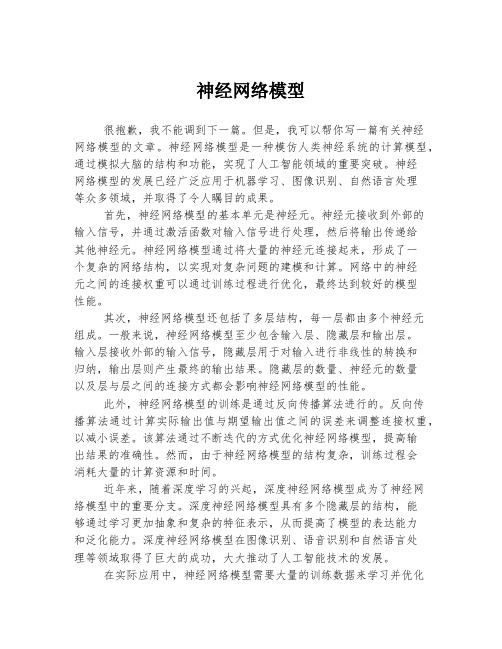
神经网络模型很抱歉,我不能调到下一篇。
但是,我可以帮你写一篇有关神经网络模型的文章。
神经网络模型是一种模仿人类神经系统的计算模型,通过模拟大脑的结构和功能,实现了人工智能领域的重要突破。
神经网络模型的发展已经广泛应用于机器学习、图像识别、自然语言处理等众多领域,并取得了令人瞩目的成果。
首先,神经网络模型的基本单元是神经元。
神经元接收到外部的输入信号,并通过激活函数对输入信号进行处理,然后将输出传递给其他神经元。
神经网络模型通过将大量的神经元连接起来,形成了一个复杂的网络结构,以实现对复杂问题的建模和计算。
网络中的神经元之间的连接权重可以通过训练过程进行优化,最终达到较好的模型性能。
其次,神经网络模型还包括了多层结构,每一层都由多个神经元组成。
一般来说,神经网络模型至少包含输入层、隐藏层和输出层。
输入层接收外部的输入信号,隐藏层用于对输入进行非线性的转换和归纳,输出层则产生最终的输出结果。
隐藏层的数量、神经元的数量以及层与层之间的连接方式都会影响神经网络模型的性能。
此外,神经网络模型的训练是通过反向传播算法进行的。
反向传播算法通过计算实际输出值与期望输出值之间的误差来调整连接权重,以减小误差。
该算法通过不断迭代的方式优化神经网络模型,提高输出结果的准确性。
然而,由于神经网络模型的结构复杂,训练过程会消耗大量的计算资源和时间。
近年来,随着深度学习的兴起,深度神经网络模型成为了神经网络模型中的重要分支。
深度神经网络模型具有多个隐藏层的结构,能够通过学习更加抽象和复杂的特征表示,从而提高了模型的表达能力和泛化能力。
深度神经网络模型在图像识别、语音识别和自然语言处理等领域取得了巨大的成功,大大推动了人工智能技术的发展。
在实际应用中,神经网络模型需要大量的训练数据来学习并优化模型参数。
同时,选择合适的网络结构和超参数也对模型的性能有着重要影响。
随着计算能力的提升和算法的改进,神经网络模型已经在许多领域取得了令人瞩目的成果,例如在医疗诊断、金融风控和智能交通等方面的应用。
为什么要使用神经网络

为什么要使用神经网络神经网络是一种模仿人类神经系统工作方式的计算机技术。
它是一种人工智能技术,可以学习和自我适应。
在今天的文章中,我们将深入探讨为什么使用神经网络。
一、神经网络的背景神经网络在上世纪50年代就已经问世,但当时因为计算机性能过于落后,加之数据的收集和处理难度大,所以没有得到广泛的推广和应用。
随着计算机技术和数据处理技术的飞速发展,现在神经网络得到了广泛的应用,尤其是在图像识别、自然语言处理和语音识别等领域。
二、神经网络的优势1. 自适应性神经网络可以不断学习和适应新的数据,能够自动调整参数和算法,准确地预测结果。
与传统的算法相比,它大大提高了准确性和效率。
2. 并行计算神经网络能够同时处理多个任务,大大提高计算效率。
它是一种并行计算的模型,能够同时进行多个操作,从而大大提高计算效率和响应速度。
3. 对噪声和缺失数据的处理能力神经网络能够有效地处理数据中的噪声和缺失数据。
它可以从一些已知的数据中推断出未知的数据,能够通过学习自适应的方法来填补数据中的缺失值。
4. 鲁棒性强神经网络对于输入数据的变化和异常噪声等问题具有很好的鲁棒性。
它不会因为输入数据的小变化而导致输出结果的巨大变化,具有稳定性和可靠性。
5. 处理非线性问题能力神经网络能够处理非线性问题。
与传统的线性模型相比,神经网络可以很好地拟合非线性数据,处理复杂的问题。
三、神经网络的应用领域1. 图像识别神经网络在图像识别领域的应用非常广泛,从简单的数字识别到人脸识别、目标跟踪等,都有着卓越的表现。
它可以自动从大量的图像中学习,从而识别和分类不同的图像。
2. 自然语言处理神经网络也可以应用于自然语言处理领域,例如自动摘要、机器翻译和语音识别等。
它可以通过学习语言模式并适应新的语言模式,从而提高其在自然语言处理领域的准确性和效率。
3. 金融风险预测神经网络在金融风险预测方面也有着广泛的应用。
它可以通过学习大量的历史数据,并预测未来可能出现的风险和变化。
如何利用神经网络进行序列标注任务(七)
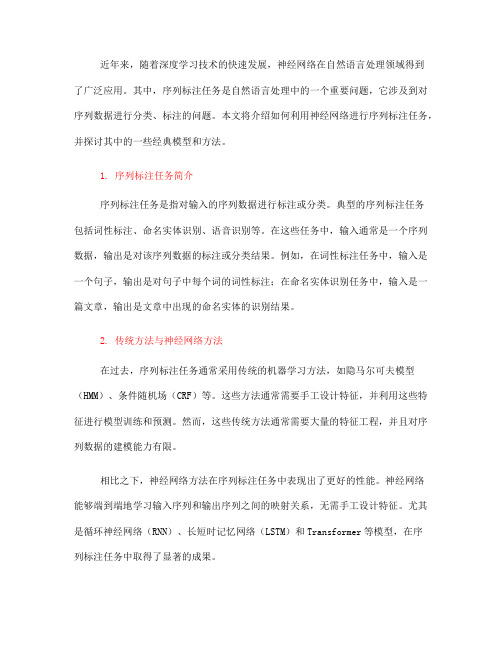
近年来,随着深度学习技术的快速发展,神经网络在自然语言处理领域得到了广泛应用。
其中,序列标注任务是自然语言处理中的一个重要问题,它涉及到对序列数据进行分类、标注的问题。
本文将介绍如何利用神经网络进行序列标注任务,并探讨其中的一些经典模型和方法。
1. 序列标注任务简介序列标注任务是指对输入的序列数据进行标注或分类。
典型的序列标注任务包括词性标注、命名实体识别、语音识别等。
在这些任务中,输入通常是一个序列数据,输出是对该序列数据的标注或分类结果。
例如,在词性标注任务中,输入是一个句子,输出是对句子中每个词的词性标注;在命名实体识别任务中,输入是一篇文章,输出是文章中出现的命名实体的识别结果。
2. 传统方法与神经网络方法在过去,序列标注任务通常采用传统的机器学习方法,如隐马尔可夫模型(HMM)、条件随机场(CRF)等。
这些方法通常需要手工设计特征,并利用这些特征进行模型训练和预测。
然而,这些传统方法通常需要大量的特征工程,并且对序列数据的建模能力有限。
相比之下,神经网络方法在序列标注任务中表现出了更好的性能。
神经网络能够端到端地学习输入序列和输出序列之间的映射关系,无需手工设计特征。
尤其是循环神经网络(RNN)、长短时记忆网络(LSTM)和Transformer等模型,在序列标注任务中取得了显著的成果。
3. 经典的神经网络模型在序列标注任务中,常用的神经网络模型包括RNN、LSTM和Transformer等。
RNN是一种经典的循环神经网络,它能够对输入序列进行逐步处理,并利用历史信息来预测当前的标注结果。
然而,RNN存在梯度消失和梯度爆炸等问题,限制了其在长序列数据上的表现。
LSTM是一种特殊的RNN结构,它通过门控单元的设计,能够更好地捕捉长距离依赖关系。
LSTM在序列标注任务中表现出了较好的性能,被广泛应用于自然语言处理领域。
另外,Transformer是近年来提出的一种新型神经网络模型,它采用自注意力机制来处理序列数据,能够并行地对输入序列进行处理,具有较好的并行性和表示能力。
人脑神经网络的工作原理
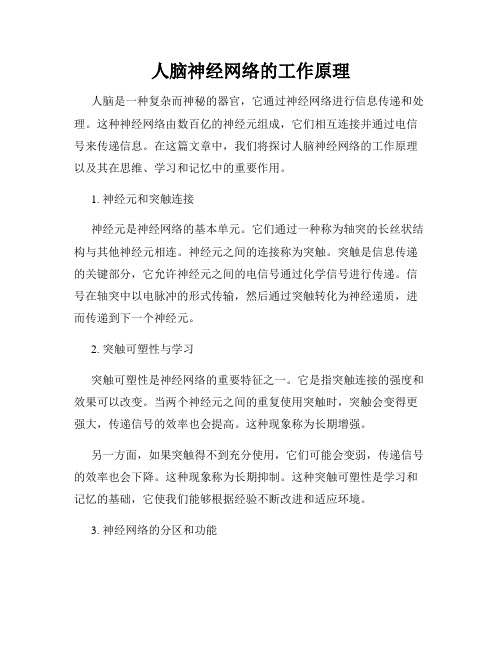
人脑神经网络的工作原理人脑是一种复杂而神秘的器官,它通过神经网络进行信息传递和处理。
这种神经网络由数百亿的神经元组成,它们相互连接并通过电信号来传递信息。
在这篇文章中,我们将探讨人脑神经网络的工作原理以及其在思维、学习和记忆中的重要作用。
1. 神经元和突触连接神经元是神经网络的基本单元。
它们通过一种称为轴突的长丝状结构与其他神经元相连。
神经元之间的连接称为突触。
突触是信息传递的关键部分,它允许神经元之间的电信号通过化学信号进行传递。
信号在轴突中以电脉冲的形式传输,然后通过突触转化为神经递质,进而传递到下一个神经元。
2. 突触可塑性与学习突触可塑性是神经网络的重要特征之一。
它是指突触连接的强度和效果可以改变。
当两个神经元之间的重复使用突触时,突触会变得更强大,传递信号的效率也会提高。
这种现象称为长期增强。
另一方面,如果突触得不到充分使用,它们可能会变弱,传递信号的效率也会下降。
这种现象称为长期抑制。
这种突触可塑性是学习和记忆的基础,它使我们能够根据经验不断改进和适应环境。
3. 神经网络的分区和功能人脑中的神经网络被分为多个区域,每个区域都负责特定的功能。
例如,大脑皮层是智力活动的中心,它处理感觉、思考和决策。
小脑负责协调运动和平衡。
基底神经节参与动作控制和习惯形成。
神经网络中的信息传递是高度并行和分布式的。
不同的神经元群组在相互之间建立复杂的连接,并通过网络传递信息。
这使得大脑能够同时处理多个任务,并在不同的区域之间进行协同工作。
4. 神经网络的模式识别神经网络在模式识别中起到重要作用。
通过在神经网络中建立特定的连接和模式,我们能够识别出不同的对象、声音和触感。
这种能力是通过大脑中的不同区域之间的相互作用来实现的。
当我们看到一张猫的照片时,大脑中的视觉区域会被激活,并通过神经网络将这个信息传递给我们的认知中心,让我们能够认出这是一只猫。
5. 神经网络的思维过程神经网络在思维过程中发挥重要作用。
思维是指我们对外界刺激的反应和信息加工过程。
RBF神经网络学习算法

RBF神经网络学习算法RBF(径向基函数)神经网络是一种常用的神经网络模型,其学习算法主要分为两个步骤:网络初始化和参数优化。
本篇文章将详细介绍RBF 神经网络学习算法的原理和步骤。
1.网络初始化(1)选择隐藏层神经元的个数隐藏层神经元的个数决定了网络的复杂度。
一般情况下,隐藏层神经元的个数越多,网络的拟合能力越强。
但是隐藏层神经元个数的选择也受限于样本的数量和特征维度。
(2)选择径向基函数径向基函数用于将输入样本映射到隐藏层,常用的径向基函数有高斯函数、多项式函数等。
高斯函数是最常用的径向基函数,其具有良好的非线性映射性质。
选择合适的径向基函数如高斯函数可以提高网络的拟合能力。
(3)确定径向基函数的参数高斯函数有一个重要参数σ,控制了函数的宽度。
确定适当的σ值可以使得网络在训练过程中收敛更快,提高网络的学习效率。
2.参数优化(1)梯度下降法梯度下降法是一种常用的优化方法,通过不断迭代网络参数来最小化误差函数。
具体步骤如下:a.随机初始化网络的权值和偏置。
b.使用前向传播计算网络的输出。
d.根据误差计算参数的梯度。
e.根据梯度和学习率更新参数。
f.重复b-e直到满足停止准则。
(2)最小二乘法最小二乘法是一种基于最小化误差平方和的优化方法。
具体步骤如下:a.设置误差函数为平方和。
b.对误差函数求偏导,并令导数为0,得到参数的闭式解。
c.使用闭式解更新参数。
3.网络训练与预测(1)网络训练(2)网络预测网络预测是指使用训练好的网络来进行新样本的预测。
给定新样本的特征向量,通过前向传播计算网络的输出,即为网络对该样本的预测结果。
总结:本文首先介绍了RBF神经网络的基本原理和结构,然后详细描述了RBF神经网络的学习算法。
网络初始化包括选择隐藏层神经元个数、径向基函数和参数的确定。
参数优化主要通过梯度下降法和最小二乘法来优化网络的参数。
最后,本文介绍了网络训练和预测的过程。
通过合理选择网络结构和参数,RBF神经网络可以有效地处理非线性问题,具有很好的拟合能力和预测能力。
Python深度学习理解pytorch神经网络批量归一化

Python深度学习理解pytorch神经⽹络批量归⼀化⽬录训练深层⽹络为什么要批量归⼀化层呢?批量归⼀化层全连接层卷积层预测过程中的批量归⼀化使⽤批量归⼀化层的LeNet简明实现争议训练深层神经⽹络是⼗分困难的,特别是在较短的实践内使他们收敛更加棘⼿。
在本节中,我们将介绍批量归⼀化(batch normalization),这是⼀种流⾏且有效的技术,可持续加速深层⽹络的收敛速度。
在结合之后将介绍的残差快,批量归⼀化使得研究⼈员能够训练100层以上的⽹络。
训练深层⽹络为什么要批量归⼀化层呢?让我们回顾⼀下训练神经⽹络时出现的⼀些实际挑战:1.数据预处理的⽅式通常会对最终结果产⽣巨⼤影响。
回想⼀下我们应⽤多层感知机来预测房价的例⼦。
使⽤真实数据时,我们的第⼀步是标准化输⼊特征,使其平均值为0,⽅差为1。
直观地说,这种标准化可以很好地与我们地优化器配合使⽤,因为它可以将参数的量级进⾏统⼀。
2.对于典型的多层感知机或卷积伸进⽹络。
当我们训练时,中间层中的变量(例如,多层感知机中的仿射变换输出)可能具有更⼴的变化范围:不论是沿着从输⼊到输出的层,跨同⼀层中的单元,或是随着时间的推移,模型的参数随着训练更新变幻莫测。
批量归⼀化的发明者⾮正式地假设,这些变量分布中的这种偏移可能会阻碍⽹络的收敛。
直观地说,我们可能会猜想,如果⼀个层的可变值是另⼀层的100倍,这可能需要对学习率进⾏补偿调整。
3.更深层的⽹络很复杂,容易过拟合。
这意味着正则化变得更加需要。
批量归⼀化应⽤于单个可选层(也可以应⽤到所有层),其原理如下:在每次训练迭代中,我们⾸先归⼀化输⼊,即通过减去其平均值并除以其标准差,其中两者均基于当前⼩批量处理。
接下来,我们应⽤⽐例系数和⽐例偏移。
正是由于这个基于批量统计的标准化,才有了批量标准化的名称。
这⾥,如果我们尝试使⽤⼤⼩为1的⼩批量应⽤⼩批量归⼀化,我们将⽆法学到任何东西。
这是因为在减去均值之后,每个隐藏单元将为0。
neural processing letters文章模板 -回复
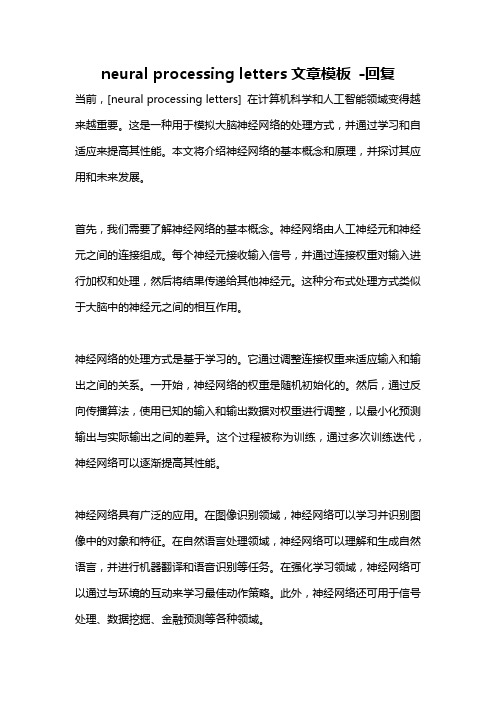
neural processing letters文章模板-回复当前,[neural processing letters] 在计算机科学和人工智能领域变得越来越重要。
这是一种用于模拟大脑神经网络的处理方式,并通过学习和自适应来提高其性能。
本文将介绍神经网络的基本概念和原理,并探讨其应用和未来发展。
首先,我们需要了解神经网络的基本概念。
神经网络由人工神经元和神经元之间的连接组成。
每个神经元接收输入信号,并通过连接权重对输入进行加权和处理,然后将结果传递给其他神经元。
这种分布式处理方式类似于大脑中的神经元之间的相互作用。
神经网络的处理方式是基于学习的。
它通过调整连接权重来适应输入和输出之间的关系。
一开始,神经网络的权重是随机初始化的。
然后,通过反向传播算法,使用已知的输入和输出数据对权重进行调整,以最小化预测输出与实际输出之间的差异。
这个过程被称为训练,通过多次训练迭代,神经网络可以逐渐提高其性能。
神经网络具有广泛的应用。
在图像识别领域,神经网络可以学习并识别图像中的对象和特征。
在自然语言处理领域,神经网络可以理解和生成自然语言,并进行机器翻译和语音识别等任务。
在强化学习领域,神经网络可以通过与环境的互动来学习最佳动作策略。
此外,神经网络还可用于信号处理、数据挖掘、金融预测等各种领域。
然而,神经网络仍然面临许多挑战和限制。
首先,神经网络的训练和调整过程需要大量的计算资源和时间。
其次,神经网络在处理复杂问题时可能会陷入局部最优解,而无法找到全局最优解。
此外,神经网络的解释性较差,难以理解其内部工作机制。
为了解决这些问题,研究人员一直在寻求改进神经网络的方法。
一种常见的方法是引入更复杂的网络结构和神经元类型,例如卷积神经网络和循环神经网络。
这些网络可以处理更多类型的数据和任务,并在图像、语音、文本等领域取得了显著的成果。
另一方面,一些研究致力于开发更有效的训练算法和优化方法。
例如,遗传算法和粒子群算法等启发式算法可以用于优化神经网络的权重和参数。
- 1、下载文档前请自行甄别文档内容的完整性,平台不提供额外的编辑、内容补充、找答案等附加服务。
- 2、"仅部分预览"的文档,不可在线预览部分如存在完整性等问题,可反馈申请退款(可完整预览的文档不适用该条件!)。
- 3、如文档侵犯您的权益,请联系客服反馈,我们会尽快为您处理(人工客服工作时间:9:00-18:30)。
9.3 Neural NetworksNeural networks are an interesting topic for artificial intelligence researchers. Since they are related to man’s nervous system construction, the results of their investigations form a foundation on which hypotheses describing the working of a brain can be built [1].Neural Network ObjectivesAlthough various neural network models to a greater or a lesser extent remind one of the actual neural network, nevertheless they do differ from it (apart from cases where such models are constructed with the intention of an exact simulation). The purpose of the limits imposed is to simplify the reasoning, and to enable the executability of algorithms devised [2].Artificial neural networks enable the execution of certain intelligent operations, e.g. associations.The analysis of these networks also provides interesting conclusions on parallel processing. Neural cells are characterized by a very long response (reaction) time (i.e. they work slowly), but because of [3] the massively parallel processing man is capable of instant execution of tasks for which conventional sequential machines require significantly more time; for instance, image recognition. Investigations of such processes will eventually lead to the design of fast algorithms that use the parallelism of artificial neurons. Parallel processing is especially important in building search algorithms employing neural networks.In the last couple of years electronic cubes containing more and more densely packed neural networks have appeared.Neural Network StructureA neural network is a set of processing units (nodes) joined by links through which they communicate. Each unit is characterized by its activation state which changes in time. From the current unit's activation state a signal it sends into the network is calculated [4]. This signal is carried over the links to other nodes. During the transmission it may be weakened or strengthened, depending upon the link's characteristics. Signals reaching a unit from its neighbors are combined into an input signal, from which the next activation state of that unit is computed [5].Network definition comprises descriptions of the following elements:⏹set of nodes⏹links⏹rules for calculating the input signal⏹activation function⏹output signal functionWe should start the characterization of processing units (neurons) by first indicating the significance of each unit. In some of the systems, single nodes clearly represent defined objects, features or concepts. This representation method is called local. Its opposite is a distributed representation, where single units denote not whole concepts but rather their abstract parts which do not have a representation in the language in which the working of a network is interpreted [6]. Only subsets of the whole network form full concept descriptions.A processing unit executes a simple sequence of operations: receives signals from neighbors, computes its activation state, and sends that state into the network. Not all units have to have the same characteristics (activation function, input signal), although networksare usually homogeneous.From the standpoint of network topology, units are classified as input, output and hidden. Input units are those which receive signals directly from the environment in which the network operates. Output units send the signal outside the network, and hidden units do not communicate directly with the environment. Sets of input and output units may contain common elements.Let us assume that a network consists of N units. Each of these units we denote by ui(1≤ i ≤ N ). A unit ui’s activation state at time t is denoted by ai(t). The whole network activation state is described, then, by a vectora(t)= (a1(t), a2(t),… , an(t))For various network models various assumptions regarding the values that an activation state can take are made [7]. These values can be continuous or discrete. A continuous value set can be bounded or unbounded [8], i.e. an activation state can be expressed by any real number or a real number from a bounded interval, e.g. [0, 1].The most common case of a discrete set are binary values, e.g. 0,1 or -1,1. The 0 (-1) state means that a unit is inactive, and 1 that it is active. Another set of values is -1, 0, 1. There are also networks possible where these values are limited to a certain well defined set, for instance 0, 1, 2, 3, 4.Units are joined by links. A link transmits a signal from one unit to the other, either strengthening or weakening it [9]. Some of the links may be excitatory. In that case, the signal transmitted [10] may increase the activation state of the receiver. Other links may be inhibitory. The signal transmitted may then lower the receiver's activation state. The power of signal transformation by a link is called the weight of that link. A weight of a link joining units ui and uj is denoted by wij [11]. Excitatory links have a positive weight while the inhibitory ones have a negative one. The lack of a link is equivalent to a link of weight 0. A signal input to a link from a unit ui's side reaches a uj unit multiplied by wij [12]. A link schema of a neural network is represented as a square weight matrix W(N×N) containing all the links' weights.In this approach it is assumed that a receiving unit treats all the incoming links the same. If this assumption cannot be upheld, the links are divided into link types, and for each link type a separate weight matrix W is given. In this section we consider only the networks with homogeneous links. Weights associated with links may change during a network learning process.A pattern of links between units determines the network topology and its capabilities. Cycle-free networks work differently to cyclic networks. Networks with just one level of links between the input and output units are inferior to multi-level networks with respect to a set of representable (recognizable) functions. The biggest capacity for function representation have fully connected networks (each node linked with every other node). The network link model is chosen depending upon its intended use.A unit's input signal is calculated from the signals sent to it and from the incoming links’weights. A unit ui’s incoming input signal at time t, denoted by neti(t), is calculated as a weighed sum of signals sent.where ok(t) is an output signal of unit uk at time t. Globally, an input signal is represented b y a vector net(t): net(t)=wo(t), where o(t)=( o1(t), o2(t), …, oN(t)) is a vector of output signals at time t. The reasoning above is applicable to networks with homogeneous links. In other cases, the value of neti(t) would be calculated by a more complicated procedure. The method of input signal calculation for a given network is constant and the same for all units.Each unit's activation state changes in time. A new state is calculated from the previous state and an input signal ai(t+1)=F(ai(t), neti(t)), and is generally expressed by the formula a(t+1)=F(a(t), net(t)), where F is an activation rule.In the simplest of cases, F does not take into account the previous activation state, and is an identity ai(t+1) = neti(t). For binary activation states, F is often given as F(x)=0 if x<0, F(x)=1 if x≥0.This means that if an input signal exceeds some threshold value a unit becomes active. Otherwise it becomes passive (inactive).For continuous activation states sets F assumes a form of sigmoidal function close [13] to a threshold function.A popular class of activation functions are quasi-linear functions, i.e. non-decreasing functions of one argument —single type input signal’s:Sometimes differentiability of the quasi-linear function is assumed. In that case it is called a semi-linear function.In some of the models an activation function is stochastic. From the input signal the probability of taking on a set value is calculated.In most models activation functions do not change in time. Exceptions are thermodynamic models, where some of the function parameters are changed. It should be noted that even unchangeable stochastic functions can, for the same data, return different values.。
